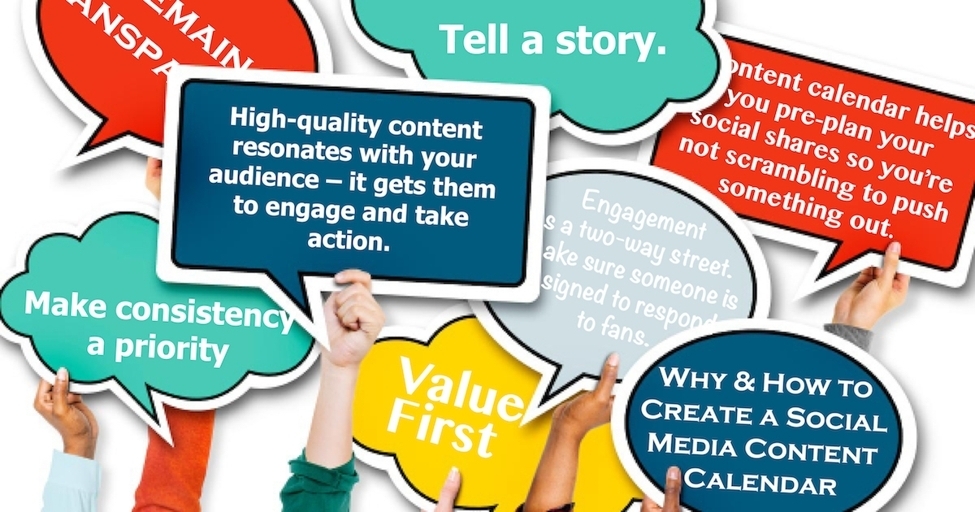
A new friend invites you over for dinner with the promise of steak and good wine. You arrive hungry to discover the steak resembles shoe leather and the wine was opened nearly a month prior.
How likely are you to accept your new friend’s second dinner invitation?
Social media is like hosting a dinner party day after day. While every status doesn’t have to rival an exceptional steak dinner, delivering garbage will cause your followers to quickly decline your invite.
In this post we’ll cover what high-quality content is in social media terms and how to consistently create high-quality content with a content calendar.
What is High-Quality Content?
In social media terms, high-quality content is content that resonates with your audience – content that gets them to engage and take action. This varies from business to business. Our customers tend to like in-depth tutorials paired with small, easily absorbable bites of information.
High-quality content resonates with your audience – it gets them to engage and take action.Click to Tweet
Your customers might thrive off insights into the inner workings of your business. They might like to see your product in action, get bits about your company history or meet your employees.
To find out what content your customers want, take a look at what is currently getting the most attention. Is it pictures, videos or links? Is it short statuses or long statuses?
Additionally, take a look at which platforms are getting the most attention? You don’t want to waste copious amounts of time in areas that aren’t being successful.
How a Content Calendar Keeps Your Consistent
“I work best under pressure.”
Does this sentiment sound familiar? There are instances when individuals and businesses churn out great content on the fly. However, typically great content is developed with weeks or even months of planning.
A content calendar helps you preplan your social shares so you’re not scrambling to push something out.Click to Tweet
1. Determine Your Post Frequency
Ultimately, how frequently you should post is determined by your audience. The more active and engaged your audience, they more frequently you can post without coming off as a spammer.
If you don’t have a good handle on your audience yet, these are some good basic standards to follow:
Facebook – 1 time per day
Twitter – 3 - 5 times per day or more
LinkedIn – 1 time per day (Monday – Friday)
Google+ – 1 time per day
Pinterest – 3 – 5 times per day
Instagram – 1 per day
2. Assign Someone to the Content Calendar
Make no mistake, managing your social media presence takes time. It’s not something staff members should simply do here and there as their schedule allows. You need to give someone (or someones) ownership of the project. And, you need to clearly define their responsibilities.
3. Create & Source Great Content
When it comes to social media, it’s ideal to share a mix of your own content and content produced by others. These tools can help you curate relevant content:
Google Alerts – Google Alerts allows you to monitor the web for the mention of specific keywords. Every time something is published using the keyword you’ve selected, Google flags it. Then, based on the frequency with which you want to be notified, they email you a list of all the mentions they have flagged.
Scoop.it – Scoop.it is another amazing tool for finding content. It allows you to create personalized content hubs and follow specific keywords. You’ll easily be able to find content on your topic and share.
Twitter’s Trends – Twitter’s Trends are listed in the left-hand sidebar of the Twitter dashboard. Twitter uses this area to highlight the hashtags and topics that are currently the most popular. Monitoring this area and perusing these topics can help you source timely information to share and/or re-share.
Newsletters – We don’t recommend you signup for every newsletter available. But, signing up for a newsletter from authors or businesses you respect is a great way to find valuable articles to share.
Not to brag, but we like to think we have a pretty darn good newsletter. Just sayin’
4. Fill Up Your Calendar
There are a variety of tools you can use to create a social media content calendar. The key is to make sure your social shares are organized by date and platform. This will allow you to visually see what’s going out when, on what platforms you are participating, and what topics you are discussing.
5. Publish, Monitor & Respond
Engagement is a two-way street. As your publish content to your different social media platforms, it’s important to monitor your content’s performance and respond to any fan engagement you receive. This mean:
Engagement is a two-way street. Make sure someone is assigned to respond to fans.Click to Tweet
Replying to Comments – While sometimes a simple, ‘Thank You’ will do, try and get more personal. If someone told you a picture you shared was beautiful, say thank you and tell them a bit about when it was taken. If a fan shares their favorite memory, let them know how much that means to you.
Meeting a Request – At times your fans might ask for a specific type of content. This could be a picture of something on-site, a video interview with one of your staff or information about where to find your product. Make sure to meet these requests.
Acknowledging Shares & Mentions – As followers share your content and mention your business, make sure to acknowledge them. This helps you build a relationship by making them feel appreciated.
What’s Next
Feeling overwhelmed? Our team can help you with everything from finding content and crafting shares to publishing and managing engagement.
Additional Reading
Social Media How-Tos: Instagram Overview Social Media How-Tos: Facebook Refresher Social Media How-Tos: Twitter Refresher Twitter Etiquette Rules to Follow How to Respond to Follows, Replies and Retweets on Twitter




